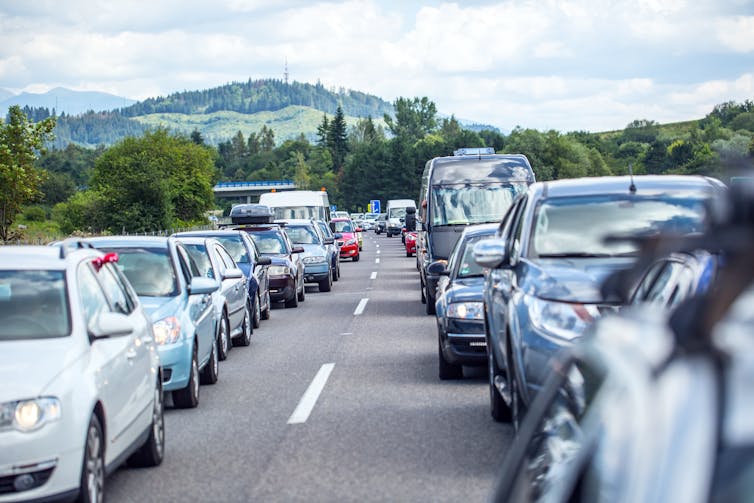
Diana Ivanova, University of Leeds and Richard Wood, Norwegian University of Science and Technology
To keep global warming below 1.5°C, we need to reduce greenhouse gas emissions equivalent to 2.5 tonnes of CO₂ per person per year by 2030. But we recently analysed more than 275,000 household budget surveys from 26 countries for an academic study, and we found that only about 5% of EU households live within these limits.
Scientists aren’t certain exactly how much fossil fuel we can use and still remain below 1.5°C – that is, how big the world’s remaining carbon budget is – but it’s clear the vast majority of EU citizens are using far more than their fair share. In the EU, the average carbon footprint is equivalent to about eight tonnes of CO₂ per person, which must fall to about a third of that level over the next decade.
But some people place even greater pressure on the environment. Households in the top 1% of polluters in the EU have carbon footprints that are 22 times larger than the safe limit of 2.5 tonnes. On average, people in this group emit greenhouse gases equivalent to 55 tonnes of CO₂ per person per year.
Consumption patterns of the top polluters
So who are these top emitters? We know they’re relatively wealthy, though perhaps not private-jet wealthy. Their annual net income is around €40,000 per person on average.
Meanwhile, the top 10% of polluters in the EU account for 27% of the total EU carbon footprint, a greater contribution than that of the bottom 50%. These stark differences in carbon footprints are rooted in the things people buy and consume.
What do the top emitters consume that produces so much waste? One of the biggest culprits in our analysis is air travel. Regular flights are responsible for 41% of the carbon footprint of the top 1% of emitters, and almost all flights taken in the EU are by the top 10% of polluters. Air travel is very unequally distributed across the population, while it is also very carbon intensive.
But air travel largely isn’t the focus of climate policies. Airlines rocked by the COVID-19 pandemic have received bailouts, while kerosene tax exemptions effectively subsidise flying, making it relatively cheap compared to other transport options.
Car travel also makes up close to a third of the carbon footprint among the top 10% of EU emitters. At the same time, poorer people spend a larger share of their wages on transport, including fuel, road tax and car insurance. Policies that increase the price of car travel, such as fuel duty rises, could hurt the poorest most if they aren’t accompanied by support for switching to cleaner alternatives such as public transport.

Marian Weyo / shutterstock
But as households get richer, travel emissions grow faster than the growth in wealth. At one end of the income divide, there’s a structural reliance on cars for travelling to work and other necessities, while at the other end, people buy new cars they don’t need and travel more as they get richer. Policymakers need to stop incentivising luxuries like air travel and better address the car dependency that is most pronounced for people with lower incomes.
To reduce the need for cars, governments should provide adequate public transport, cycling and walking infrastructure. They should also help to redesign cities, increase urban density of residents and jobs and actively target social practices and business models that reinforce car reliance.
Avoiding flying, living car-free and eating a vegan diet can reduce personal carbon footprints. But the reductions are generally insufficient to meet the 2.5 tonnes carbon targets. This is largely because of fossil-fuel dependence throughout the economy.
Carbon footprints and wellbeing
As things stand, living within climate limits most often means living in inadequate conditions, with fewer opportunities to travel or buy things. This is especially true in EU countries that rely heavily on coal to generate energy, such as Estonia and Bulgaria.
But the link between carbon footprints and income is highly complex. While the wealthiest are clearly responsible for the highest emissions, Denmark and France have much lower carbon footprints for the same level of income compared with other European countries. This could be because they generate more of their electricity from nuclear and renewables. Both countries also have comparably robust welfare states, with expansive public services and public transport. This could ensure that people there have more of their basic needs met and aren’t as compelled to buy lots of stuff, as in other countries.
If 95% of EU households live beyond planetary limits, we need ambitious and radical change. Reducing the carbon intensity of global supply chains could ensure that everyone can have adequate nutrition, shelter, education, healthcare and mobility within planetary limits. Airport expansions, motorway extensions and fossil fuel subsidies are locking us into a future with less opportunity to achieve climate targets and a good standard of living for all in Europe and around the world.
This article was updated on August 28, 2020 to make it clear EU carbon footprints must fall “to” a third of their previous level, not “by a third” as previously stated.![]()
Diana Ivanova, Research Fellow, University of Leeds and Richard Wood, Professor of Industrial Ecology, Norwegian University of Science and Technology
This article is republished from The Conversation under a Creative Commons license. Read the original article.




